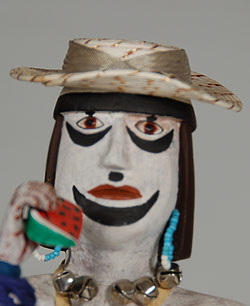Hopi Köcha Tsuku Clown Mocking the Navajo [SOLD]
+ Add to my watchlist Forward to Friend
- Category: Traditional
- Origin: Hopi Pueblo, Hopituh Shi-nu-mu
- Medium: wood, yarn, beads, buckskin
- Size: 12” tall
- Item # C3383Z SOLD
 According to Barton Wright, the Köcha Tsuku (White Clowns) are identical with the Sikya Tsutskutu (Yellow Clowns) except that they paint their bodies white instead of yellow. They generally cover their heads with a scarf or hat as illustrated in this carving by Henry Shelton. Under the straw hat, the artist has painted the head in black and white stripes as seen on Hopi Koshari clowns. The turquoise earrings and Ketoh being worn are reflections of typical Navajo men and their jewelry.
According to Barton Wright, the Köcha Tsuku (White Clowns) are identical with the Sikya Tsutskutu (Yellow Clowns) except that they paint their bodies white instead of yellow. They generally cover their heads with a scarf or hat as illustrated in this carving by Henry Shelton. Under the straw hat, the artist has painted the head in black and white stripes as seen on Hopi Koshari clowns. The turquoise earrings and Ketoh being worn are reflections of typical Navajo men and their jewelry.
Henry Shelton, who’s Hopi name is Ho-ya’oma, translated to Arrow Carrying, is from the village of Oraibi on Third Mesa on the Hopi Reservation. His father was Peter Shelton, Sr. and his brother is Peter Shelton, Jr. both of whom were carvers of katsina dolls. Henry attended the Santa Fe Indian School from 1944 to 1949. His awards and exhibitions are too numerous to mention here. He devoted much of his life to creating katsina dolls, paintings, and sculptures. He is in collections of the Smithsonian, Museum of Northern Arizona, Kansas State Historical Society, Denver Art Museum and Heard Museum and many private collections. His work is eagerly sought.
Condition: original condition
Provenance: from the estate of Tom Mittler, a former resident of Michigan and Santa Fe who purchased it at Rainbow Man in Santa Fe in 1986
Recommended Reading: Clowns of the Hopi: Tradition Keepers and Delight Makers by Barton Wright
- Category: Traditional
- Origin: Hopi Pueblo, Hopituh Shi-nu-mu
- Medium: wood, yarn, beads, buckskin
- Size: 12” tall
- Item # C3383Z SOLD



